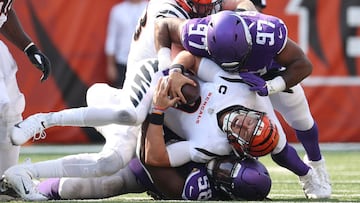What is the NFL concussion protocol?
Besides the high frequency of concussions in the NFL, research has shown that head injuries can cause serious neurological problems.

Following the concussion sustained on Thursday night by Dolphins quarterback Tua Tagovailoa, the NFL concussion policies are sparking concern across the league, once again.
Many people who watched the Thursday night game were highly critical of how Miami has treated Tagovailoa over the past week, having cleared him to play after suffering a hard hit in the team’s Sep. 25 game against the Buffalo Bills .
Earlier this week, the league union even said it would be investigating the Dolphins for their concussion evaluation process.
So what is the actual NFL concussion protocol?
NFL creates concussion protocol
The National Football League has created policies to address head injuries, and the NFL concussion protocol is the first line of defense on game day.
The protocol aims to identify and treat concussions in the NFL more quickly.
Related: The concussion discussion in the NFL
During each game, there are assigned spotters who monitor the players on the field. If they see an impact to the head, they call a timeout. The player is escorted off the field to be examined and evaluated.
Aside from the spotters, other people can initiate the protocol, including the team trainer, coach or physician, NFL game officials, and the player’s teammate.
If signs of a concussion are spotted, the player will be brought to the medical tent, locker room, or hospital for further examination.
5-step return-to-participation process
After being sidelined, the player must undergo a five-step process before being allowed to take the field again.
The first step involves rest and limiting activities which may increase or worsen symptoms. The player may do stretching and balance activities. If the patient does not develop signs of a concussion, he may be cleared to go to the next phase.
Phase two involves the start of a graduated aerobic exercise program. He must show that he can engage in cardiovascular exercise without aggravating his symptoms.
In phase three, the player will engage in exercises that begin to mimic football-specific activities. He may also practice supervised strength training.
In the fourth phase, the patient may participate in club-based non-contact training drills. These include throwing, catching, and running.
The fifth and final phase involves taking part in full football practice, with full contact. Once the player has thoroughly practiced, the next step is being cleared by the Club physician.
After that, he must be examined by the Independent Neurological Consultant. If cleared, he will be allowed to play in the next game.
Link between concussions and CTE
Studies have found a connection between repeated blows to the head and chronic traumatic encephalopathy or CTE. This degenerative brain disease can cause depression, anxiety, memory loss, and dementia.
The brains of NFL players were among 1,000 that were part of a study on brain trauma, and around two-thirds of the total sample were found to have CTE.






